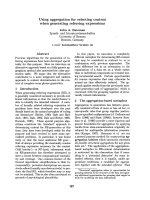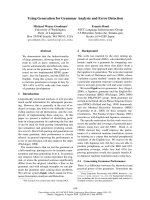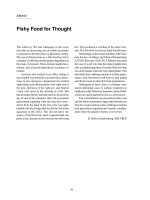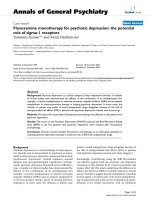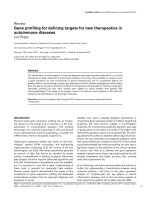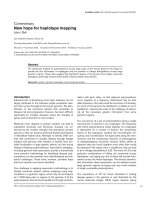Báo cáo y học: "Using pump for bypass surgery – on-off-on again" pdf
Bạn đang xem bản rút gọn của tài liệu. Xem và tải ngay bản đầy đủ của tài liệu tại đây (131.37 KB, 3 trang )
Expanded abstract
Citation
Shroyer AL, Grover FL, Hattler B, Collins JF, McDonald
GO, Kozora E, Lucke JC, Baltz JH, Novitzky D for the
Veterans Aff airs Randomized On/Off Bypass (ROOBY)
Study Group: On-pump versus off -pump coronary artery
bypass surgery. N Engl J Med 2009, 361:1827-37
Background
Coronary-artery bypass grafting (CABG) has tradition-
ally been performed with the use of cardiopulmonary
bypass (on-pump CABG). CABG without cardio-
pulmonary bypass (off -pump CABG) might reduce the
number of complications related to the heart-lung
machine.
Methods
Objective: To compare off -pump to on-pump CABG in
terms of short- and long-term composite of compli-
cations and death from any cause, as well as completeness
and durability of the procedure/grafting, neuro psycho-
logical outcomes, and use of major resources.
Design: Multi-center single-blind, randomized controlled
trial.
Setting: 18 Veterans Aff airs medical centers, 16 of which
were teaching hospitals.
Subjects:
2203 patients who were scheduled for urgent or elective
CABG-only procedures.
Intervention: Patients were randomized to either on- or
off -pump CABG. ey underwent neuropsychological
testing at baseline and one year, as well as follow-up
angiography.
Outcomes: 1) Primary short-term end-point: composite
of death or major complications (reoperation, new mech-
a nical support, cardiac arrest, coma, stroke or renal
failure requiring dialysis) at discharge or day 30. 2) Primary
long-term composite end-point: death from any cause
within 1 year, nonfatal myocardial infarction between
30days and 1 year, or repeat revascularization between
30 days and 1 year. 3) Secondary outcomes: completeness
of revascularization, graft patency at 1 year, scores on
neuropsychological tests.
Results
ere was no signifi cant diff erence between off -pump
and on-pump CABG in the rate of the 30-day composite
outcome (7.0% and 5.6% respectively, P=0.19). e rate
of the 1-year composite outcome was higher for off -
pump than for on-pump CABG (9.9% vs 7.4%, P=0.04).
e proportion of patients with fewer grafts completed
than originally planned was higher with off -pump CABG
than with on-pump CABG (17.8% vs 11.1%, P <0.001).
Follow up angiograms in 1371 patients who underwent
4093 grafts revealed that the overall rate of graft patency
was lower in the off -pump group than in the on-pump
group (82.6% vs. 87.8%, P <0.01). ere were no
treatment-based diff erences in neuropsychological
outcomes or short-term use of major resources
Conclusions
At 1 year of follow-up, patients in the off -pump group
had worse composite outcomes and poorer graft patency
than did patients in the on-pump group. No signifi cant
diff erences between the techniques were found in the
neuropsychological outcomes or use of major resources.
Commentary
Cardiopulmonary bypass (CPB) was developed in 1954
and revolutionized cardiac surgery [1]. Almost since its
inception, there has been literature attributing neuro-
cognitive dysfunction, as well as a post-operative systemic
infl ammatory response syndrome (SIRS)-like pheno me-
non associated with organ failure, to the CPB machine
used in cardiac surgery [2,3]. In the 1990s, cardiac
surgeons responded by developing “off -pump” coronary
artery bypass grafting (CABG), and this new technique has
grown in popularity among surgeons and patients, the
latter often requesting the procedure to avoid “pump-head.”
© 2010 BioMed Central Ltd
Using pump for bypass surgery – on-o -on again?
Jennifer H Edwards
1
and David T Huang*
1,2,3
University of Pittsburgh Department of Critical Care Medicine: Evidence-Based Medicine Journal Club, edited by Sachin Yende
JOURNAL CLUB CRITIQUE
*Correspondence:
606B Scaife Hall, 3550 Terrace Street, University of Pittsburgh, Pittsburgh, PA 15261,
USA
Full list of author information is available at the end of the article
Edwards and Huang Critical Care 2010, 14:319
/>© 2010 BioMed Central Ltd
Numerous large observational studies and small
randomized trials have been published in the past 15
years suggesting benefi ts from off -pump CABG. Among
these benefi ts are a reduction in stroke, time on
mechanical ventilation, need for reoperation, bleeding,
wound infection, renal failure, post-operative length of
stay [4] and decreased atrial fi brillation and inotrope
requirement [5].
Enthusiasm was tempered by studies that showed that
not only was the new technique perhaps inferior in
achieving the goal of complete and durable revascu-
larization [6], but also was associated with reduced
survival and an increase in non-fatal cardiac-related events
at 4 to 6 months [7]. A 2005 meta-analysis noted that
randomized controlled trials did not fi nd the statistically
signifi cant reductions in short-term morbidity and
mortality demonstrated by observational studies [8].
Finally, a sub-analysis of a large randomized controlled
trial concluded that the apparent benefi ts of off -pump
CABG essentially disappeared when the morbidity and
mortality of emergency intra-operative conversion to the
on-pump procedure were taken into account [9,10].
Into this setting the current paper was published as the
largest randomized, controlled, single-blinded trial to
evaluate the issue [11]. e study was designed to detect
a reduction in major morbidity and mortality at both 30
days and 1 year for the off -pump procedure compared to
the on-pump procedure. It also compared rates of
achieving the anatomical goal of the operation—complete
and durable revascularization—and results of neuro-
psychological tests.
Of note, there is some inconsistency between the
authors’ written hypothesis and the statistical design and
power of the trial. e hypothesis in the 2007 clinical
trials design paper [12] and the fi nal NEJM paper [11]
reads “We hypothesized that there would be no diff erence
between the on-pump and off -pump procedures for the 2
primary outcomes.” is describes an equivalence/non-
inferiority trial, whereas the study was powered to
demonstrate superiority of off -pump CABG over on-
pump CABG. is discrepancy is a recurrent and
important theme in study design [13,14] and had the
study failed to show superiority of one technique over the
other, it would have been underpowered to address its
stated null hypothesis.
e authors found no diff erence between the two
procedures in post-operative complications and short-
term death from any cause. However, at 1 year, patients
who underwent off -pump CABG had a signifi cantly
higher rate of the composite endpoint of morbidity and
mortality, and death from cardiac causes, while no
diff erences were observed in all-cause mortality. With
regards to secondary outcomes, they found that patients
who underwent off -pump CABG had signifi cantly less
complete (fewer grafts done than planned) and less
durable (decreased patency at one year) revascularization.
ere was no diff erence in neuropsychological outcomes
or resources used. In summary, this study found harm
rather than benefi t from undergoing an off -pump CABG,
most likely secondary to incomplete and less durable
revascularization.
is study was a large, rigorously designed and
executed study that addressed important clinical
questions. For the population studied, it provided a
defi nitive answer: on-pump CABG is better than off -
pump CABG. However, some questions remain.
1) To what patient population are these results applicable?
Among the patients excluded from the trial were 3282
patients who needed emergent operation or were
considered too high risk. Study patients were generally
male, and, some respondents to the paper have claimed,
healthier and younger than the average CABG population
[15]. Observational data have suggested that off -pump
CABG is better for women, the elderly, and those with
severe coexisting illnesses [16]. In addition, the off -pump
procedure may reduce the risk of stroke in patients with
atheromatous aortas [17]. Future studies may reveal the
specifi c types of patients who will benefi t from off -pump
CABG.
2) Was the technical experience of the surgeons and
anesthesiologists in this study su cient, and how much
experience with o -pump CABG is enough to ensure
pro ciency?
e 12.4% intraoperative conversion from off -pump to
on-pump CABG (5 times the rate reported in the
National Database of oracic Surgeons) has been touted
as evidence of the study practitioners’ inexperience [18].
e authors addressed the issue of surgeon experience by
doing a sensitivity analysis based on high volume (>50
pre-study cases) versus low volume (< 50 pre-study cases)
operators, and found no signifi cant diff erence in
outcomes. is suggests that the results could be
generalized to surgeons with variable off -pump
experience. In addition, they excluded cases that crossed
over to on-pump CABG and found no diff erence in the
results. Nevertheless, some will question whether even
50 cases are suffi cient to be considered profi cient [15],
and the experience of the anesthesiologist was not
addressed. Although residents were considered the
primary surgeon in many of the cases, this did not appear
to have a clinical eff ect. e rate of complication in the
study was lower than that typically published for both
on- and off -pump CABG, and the group that involved
more resident-surgeons (on-pump CABG) had a better
outcome than that of the group that had fewer resident-
surgeons (off -pump CABG).
Edwards and Huang Critical Care 2010, 14:319
/>Page 2 of 3
3) What happened to the neurocognitive injury long
associated with CPB? Is this a case of disappearing
morbidity?
Consistent with some previous studies, this study failed
to show neurocognitive dysfunction associated with CPB
[16]. It is possible that CPB has undergone such technical
refi nement that the cognitive eff ects seen earlier are no
longer a risk, or perhaps now only occur in the subgroup
of patients largely excluded from this trial (women, the
elderly, and more severely ill). e primary risk for
neurocognitive dysfunction may now lie with the surgery
itself, not CPB.
Recommendation
Patients who fi t the trial’s inclusion criteria (men at low-
to-moderate risk of death at 30 days and peri-operative
complications), which will include many of those at the
VA and most cardiac surgical groups, should now be
counseled to undergo on-pump CABG. Sub-groups such
as women and high-risk men that may benefi t from off -
pump CABG will likely be the subject of further studies.
Future advances in CPB and off -pump CABG could yet
change the landscape of this debate.
Competing interests
The authors declare that they have no competing interests.
Author details
1
Department of Critical Care Medicine, University of Pittsburgh, Pittsburgh, PA.
2
The Clinical Research, Investigation, and Systems Modeling of Acute Illness
(CRISMA) Center, University of Pittsburgh, Pittsburgh, PA.
3
Department of
Emergency Medicine, University of Pittsburgh, Pittsburgh, PA.
Published: 16 September 2010
References
1. Kurusz M: Cardiopulmonary bypass: past, present, and future. ASAIO J 2004,
50:xxxiii-xxxxvi.
2. Newman MF, Kirchner JL, Phillips-Bute B, Gaver V, Grocott H, Jones RH, Mark
DB, Reves JG, Blumenthal JA: Longitudinal assessment of neurocognitive
function after coronary-artery bypass surgery. N Engl J Med 2001,
344:395-402.
3. Wan S, LeClerc JL, Vincent JL: In ammatory response to cardiopulmonary
bypass: mechanisms involved and possible therapeutic strategies. Chest
1997, 112:676-692.
4. Cleveland JC, Jr., Shroyer AL, Chen AY, Peterson E, Grover FL: O -pump
coronary artery bypass grafting decreases risk-adjusted mortality and
morbidity. Ann Thorac Surg 2001, 72:1282-1288.
5. Angelini GD, Taylor FC, Reeves BC, Ascione R: Early and midterm outcome
after o -pump and on-pump surgery in Beating Heart Against
Cardioplegic Arrest Studies (BHACAS 1 and 2): a pooled analysis of two
randomised controlled trials. Lancet 2002, 359:1194-1199.
6. Hannan EL, Wu C, Smith CR, Higgins RS, Carlson RE, Culliford AT, Gold JP,
Jones RH: O -pump versus on-pump coronary artery bypass graft surgery:
di erences in short-term outcomes and in long-term mortality and need
for subsequent revascularization. Circulation 2007, 116:1145-1152.
7. Caputo M, Reeves BC, Rajkaruna C, Awair H, Angelini GD: Incomplete
revascularization during OPCAB surgery is associated with reduced mid-
term event-free survival. Ann Thorac Surg 2005, 80:2141-2147.
8. Wijeysundera DN, Beattie WS, Djaiani G, Rao V, Borger MA, Karkouti K,
Cusimano RJ: O -pump coronary artery surgery for reducing mortality
and morbidity: meta-analysis of randomized and observational studies.
JAm Coll Cardiol 2005, 46:872-882.
9. Jones RH: Intraoperative crossover: the well-kept surgical secret to
apparent surgical success. J Am Coll Cardiol 2005, 45:1529-1531.
10. Patel NC, Patel NU, Loulmet DF, McCabe JC, Subramanian VA: Emergency
conversion to cardiopulmonary bypass during attempted o -pump
revascularization results in increased morbidity and mortality. J Thorac
Cardiovasc Surg 2004, 128:655-661.
11. Shroyer AL, Grover FL, Hattler B, Collins JF, McDonald GO, Kozora E, Lucke JC,
Baltz JH, Novitzky D: On-pump versus o -pump coronary-artery bypass
surgery. N Engl J Med
2009, 361:1827-1837.
12. Novitzky D, Shroyer AL, Collins JF, McDonald GO, Lucke J, Hattler B, Kozora E,
Bradham DD, Baltz J, Grover FL: A study design to assess the safety and
e cacy of on-pump versus o -pump coronary bypass grafting: the
ROOBY trial. Clin Trials 2007, 4:81-91.
13. Le Henan A, Giraudeau B, Baron G, Ravaud P: Quality of reporting of
noninferiority and equivalence randomized trials. JAMA 2006,
295:1147-1151.
14. Piaggio G, Elbourne DR, Altman DG, Pocock SJ, Evans SJ: Reporting of
noninferiority and equivalence randomized trials: an extension of the
CONSORT statement. JAMA 2006, 295:1152-1160.
15. Kieser TM: On-pump versus o -pump CABG. N Engl J Med 2010,
362:852-854.
16. Peterson ED: Innovation and comparative-e ectiveness research in cardiac
surgery. N Engl J Med 2009, 361:1897-1899.
17. Bucerius J, Gummert JF, Borger MA, Walther T, Doll N, Onnasch JF, Metz S, Falk
V, Mohr FW: Stroke after cardiac surgery: a risk factor analysis of 16,184
consecutive adult patients. Ann Thorac Surg 2003, 75:472-478.
18. Puskas JD, Mack MJ, Smith CR: On-pump versus o -pump CABG. N Engl J
Med 2010, 362:851-854.
doi:10.1186/cc9248
Cite this article as: Edwards JH, Huang DT: Using pump for bypass surgery –
on-o -on again? Critical Care 2010, 14:319.
Edwards and Huang Critical Care 2010, 14:319
/>Page 3 of 3

